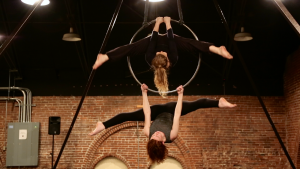PREVIEW Escape Velocity

Picking up where The Glassblock left off last year and as part of a Recital sponsored partnership with the New Hazlett Theater, Recital is presenting a series of editorially-independent previews and reviews of the 2017–2018 Community Supported Art (CSA) Performance Series. Below is their review of Escape Velocity by Double Blind Productions, a collaborative response from Recital editor David Bernabo, season review panelist Jason Baldinger, and guest panelist Maggie Lynn Negrete.
By David Bernabo
In 15th century Italy, the tarot card emerged. Hand-painted in small editions, tarot decks were originally used to play games, not for divination. War spread these early decks to Switzerland and France, variations and mutations of game rules emerged, and in the 18th century, tarot card-based games like the Austrian Bauerntarock, the French jeu de tarot and the Italian tarocchini became extremely popular throughout Europe.
Around 1789, Etteilla, the pseudonym of French occultist Jean-Baptiste Alliette, was the first person to issue a tarot deck for divination purposes, alongside a few publications discussing how tarot cards could be used in cartomancy — fortune-telling using a deck of cards. Freemasons elevated this humble game deck to a source of ancient wisdom. Occult author Éliphas Lévi linked tarot to the Kabbalah. From there, esoteric tarot entered the wider public consciousness and inevitably became an influence for art projects — French artist Niki de Saint Phalle spent two decades sculpting the impressively large and intricate Tarot Garden in Tuscany, film director Terrence Malick drew upon tarot cards to structure his Knight of Cups film, and video games like The Fool’s Errand, Persona, and The Blinding of Isaac all use tarot cards as some sort of inspiration or power-up feature.
